Porcelain Insulator News
by Elton Gish
Reprinted from "Crown Jewels of the Wire", April 2001, page 20
Over the years many people have sent photographs of their porcelain
insulators many of which are quite colorful or have beautifully mottled tan or
light brown glazes. I sorted through several albums of photos in an effort to
select the best photos to reproduce in this first ever color PIN. I tried to run
as many photos as possible and hope you find the beautiful world of porcelain
represented here as exciting as I do. If you would like to see more color
photographs, please check out my web site at www.r-infinity.com.
Since my new
book, Multipart Porcelain Insulators, 2nd edition, was published this summer, I
thought we would run photos of multiparts. Many of you may think that multipart
porcelain insulators are just ugly chocolate-brown boat anchors. Here are number
of photographs that will change your mind. Not too long ago Ed Sewall and Robin
Harrison recovered six M-3250's, several N-N Thomas M-4425's, and two N-N Thomas
M-4422's from an undisclosed transmission system in western Washington.
The
first photo (color insert) shows Ed and Robin standing next to their trophy of
six M-3250's. The two in the center have beautiful mustard/ orange glazes on all
skirts. The other four have various mixed colored skirts and are beautiful and
unique in their own right. The contrasting mustard skirts with dark brown top
skirts is very interesting. I don't know how they managed to split the find of
rare M-3250's (photo 2). Only four others are known. The first three M-3250's
reported (see CJ 5-94-15) were found in New York area and are much less
attractive. In 1996, I got a beautiful orange and mustard M-3250 from Jim
Sinsley. It rivals the prettiest of the ones Ed and Robin found and may have
come from the same system. All of the known M-3250's were unmarked and made by
R. Thomas & Sons probably around 1905-1910. The seven M-3250's found in
the northwest were mounted on large wooden pins that nearly filled the bottom
skirt.
Ralph Mershon specially designed M-3250's for the Shawinigan Water &
Power Co. 84-mile line from Shawinigan Falls to Montreal. The line was put into
service in early 1903 at 50,000 volts. The first M-3250's were made with a white glaze. Only pieces of white M-3250's have been discovered
in a dump in New York.
Another one of Mershon's designs was M-3740, which was
also made by Thomas. The most colorful M-3740 was discovered by Ed Sewall who
found it in the Washington Water Power substation in Sprague, WA. No other
M-3740 comes close to this coloration so it may be the oldest specimen known (photo
3). All of the M-3740's I have seen have rather dark glazes usually near
black with some brown mottling. The three Mike Spadafora recovered about 15
years ago from the Toronto & Niagara Power Co. line were lighter richly
colored brown with some mottling of dark mustard.
WWP's standard multipart
insulator in the northwest was M-4325. The next insulator (photo 4) was one of
several Ed Sewall found in the Washington on the Nooksack River line most of
which had the typical tiger strip mottling on the top skirt. Some have more
mustard coloration in the skirts than the one shown in the photograph. These
were made by Thomas and have the characteristic blue-jean seam inside the bottom
skirt.
The next two insulators shown in the same photograph (photo 5) are in the
collection of Jeff Hogan. The one on the left is M-3230. Thomas made it circa
1905-1906 and has their early mustard glaze highlighted with orange and rich
brown colors. Note the large chip on the edge of the top skirt that has been
glazed over. The insulator on the right is M-2450, which is also a Thomas
product. Note the beautiful contrast of mustard top skirt and darker bottom
skirt. What makes this one even more special is that it was put together with
sulfur cement!
The next insulator appears to be M-3230. In fact, Tim Wood
assumed this when he first reported it. Closer inspection by Robin Harrison
revealed that it was a 3-part glazeweld rather than three shells cemented
together. Technically this makes it a unipart style so I have assigned it U-968
(photo 6). Note the nearly all mustard glaze, which indicates it was made
earlier than the M-3230 in Jeff's collection. In fact, U-968 was quickly
converted to a cemented M-3230 because it afforded more strength and it was
easier to produce in three separate shells rather than the parts stacked
together, added glaze poured in, and fired together as one unit. This is the
only known example of U-968. It has the characteristic Thomas blue-jean seam
inside the bottom skirt and a very definite crosshatch pattern left by the denim
fabric which was apparently used to prevent the threading mandrel from sticking
to the clay. U-968 was probably made circa 1903-1905.
Bill Rohde has recovered
most of the various "ringed" insulators in California where they were
used extensively and a few are still in service. The next photograph is an
M-4415 with 10 concentric rings under the top skirt (photo 7). Most of the
insulators with rings or ridges under the top skirt were made by Thomas circa
1906-1910. Thomas made four styles with this feature including a recently discovered M-4600 with 11 ridges. Lima also
made M-4600 but it has 13 ridges. The ridges were claimed in the 1906 Baum
patent. The patent showed the ridges under the middle and bottom skirts with
short thin petticoats under the top skirt. The short thin petticoats were used
on the very rare specimens of Lima M-4604 that was just discovered this year.
This style was quickly changed by replacing the petticoats with rings under the
top skirt. The petticoats and ridges served to extend the electrical leakage
path to increase the voltage rating.
Most of you have seen the Fred Locke
M-2795. The porcelain top comes in a wide variety of tan and brown glazes often
with attractive mottling. But have you ever seen the only known white M-2795?
I've had it in my collection for over 15 years. It has the manufacturing date of
"DEC 7 1900" which is one of the earliest dates reported on M-2795's (photo
8). No one knows why it was produced with a white glaze or where it was
used although we are sure it was used in California. Legend has it that one or
two more were seen in southern California.
Mike Spadafora recently found the
only three known specimens of M-3721A on the Locke 25 line in Colorado. The line
was built in 1904 from the Skagway Power House near Victor, CO to the city of
Pueblo, CO. All M-3721B's were damaged but went back together nicely. This is
one of the best ones with a nice drippy glaze (photo 9). The insulators were
made by Fred Locke and bear his 7-date marking on the top skirt. Actually a
mixture of Fred Locke shells were used on the line that resulted in three unique
multipart styles. Perhaps Locke had difficulty filling the order for the all
glass CD 342 Locke 25 and completed the order using extra parts of porcelain
multipart insulators from the warehouse. Mike also recovered three
"kitsulator" CD 342's from the line.
The next insulator, M-4325A, is
in Bill Rohde's collection (photo 10). It was found by Mike Spadafora on the old
30 kV Borel line. The line ran from the power plant on the Kern River, across
the desert over Tehachapi Pass, and on to Los Angeles. M-4325A's have various
manufacturing dates from Dec 12 1903 and Jan 26 1904. The M-4325A's dated in 1904
also had the incuse marking, "PATENTED/June 17 1890". The 1890 patent
is the Oakman patent. You can learn more about this glass insulator patent and
why it was used on multiparts in my book, Multipart Porcelain Insulators, 2nd
edition. New Lexington was asked to make M-4325A probably because Fred Locke
could not fill the entire order for M-3721's which was the primary insulator
used on this line. M-4325A is identical to M-3721 except the collar is cemented
rather than glazewelded. Both were mounted on steel pins with a porcelain pin
sleeve for additional insulating properties. M-4325A is about equally rare as
the Fred Locke M-3721. The M-4235A's have one or more blonde-colored skirts that
takes "light tan" to an extreme. Bill's M-4325A is unique in that all four skirts (includes the cemented collar under the top
skirt) are blonde!! Truly one of the most beautiful multipart porcelain
insulators. I nearly forgot to mention another unique feature of M -4325A. The
top skirt on all multipart porcelain insulators has an unglazed firing rest on
the top of the crown. The New Lexington M-4325A is the only multipart to have a
fully glazed crown! The top skirt was apparently fired resting on ceramic or
metal supports underneath and inside the cavity formed to fit the collar and
middle skirt that was cemented in place.
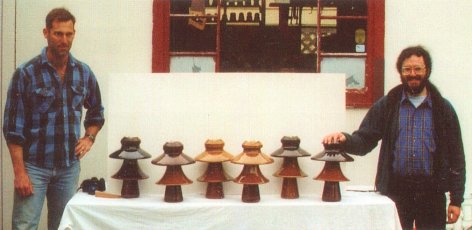
(1.) Ed Sewall and Robin Harrison with six beautiful M-3250's.
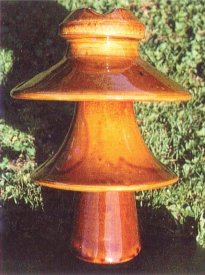
(2.) One of Ed and Robin's M-3250's. The top and
middle skirts are mostly
mustard colored and the bottom
skirt has more orange and caramel.
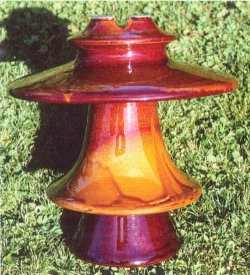
(3.) M-3740.
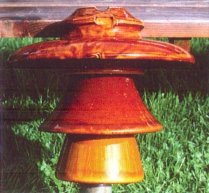
(4.) M-4325.
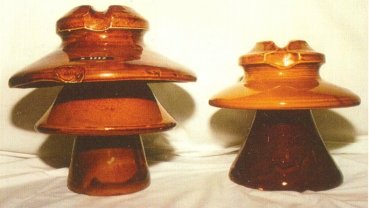
(5.) (Left) M-3230, (Right) M-2450
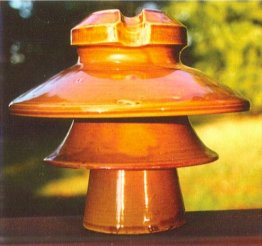
(6.) Early Thomas 3-part glazeweld, U-968.
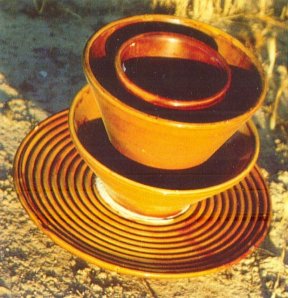
(7.) Thomas M-4415 with 10 rings or
ridges under the top skirt.
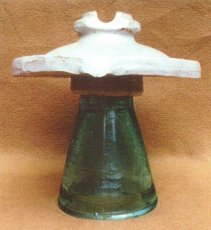
(8.) M-2795 Fred Locke with white porcelain top.
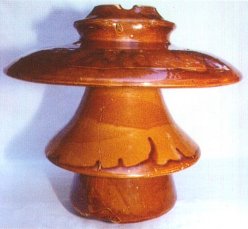
(9.) M-3721B Fred Locke.
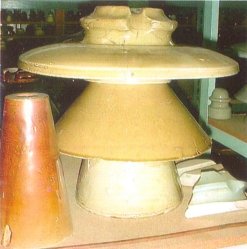
(10.) M-4325A New Lexington
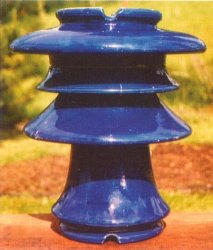
(11.) M-4360 Pittsburg
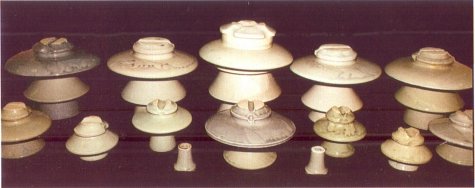
(12.) Bill Rohde's collection of old gray multi parts.
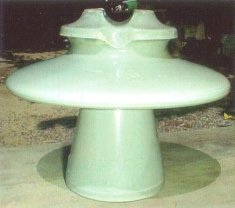
(13.) Gray M-2430 Victor
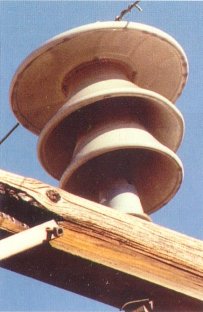
(14.) M-3451
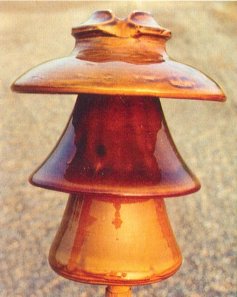
(15.) M-3451 Thomas
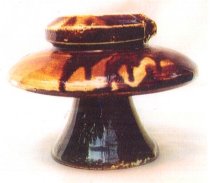
(16.) M-2141 Pittsburg

(17.) Nice group of Fred Locke M-2795's showing glaze variations.
Tim Wood discovered the next insulator,
which is the only known whole specimen of M-4360 (see CJ 9-96-35). The badly
damaged specimen he found with it has a Pittsburg date control stamp. The glaze
color is dark blue!! Not dark like a cobalt blue glaze, but a fantastic richly
colored blue (photo 11).
The next photograph shows Bill Rohde's collection of
gray multipart insulators (photo 12). The color on the old gray-glazed
multiparts is difficult to capture accurately on film. The gray multipart styles
were produced around 1904-1912 and maybe a year or so later in the Washington
Water Power district. They were made by Locke, Thomas, and Ohio Brass. This next
photograph shows the only known gray M-2430 (photo 13). It is owned by Bill
Rohde and bears the large insulator logo R=oo marking on the top skirt. Most
Locke gray glazes have a bluish cast and some can be considered light blue
rather than gray. Thomas gray glazes usually have a slight greenish cast, and
the Ohio Brass gray glaze is a flat gray without a hint of color.
Bill Rohde
took the next photograph of a gray M-3451 still in service somewhere in
California (photo 14).
The next photo shows Bill Rohde's beautiful M-3451 N-N
Thomas. The glossy glaze is a combination of mustard and rich mottled brown (photo
15).
Beautifully glazed multiparts were also produced by Pittsburg. You
have a hard time finding a more attractive drippy glaze than the crudely made M-2141 in my collection shown in the next photograph
(photo 16). This insulator
was buried in a collection for many years. I bought several hundred insulators
in a group to get this one insulator. The tie-wire groove is cut lopsided in a
crude fashion often seen in Pittsburg insulators.
The last photograph is one I
managed to fit in on the allotted pages for the color spread. It shows four Fred
Locke M-2795's in Bill Rohde's collection that give you an excellent example of
the wide variety of glaze colorations that can be found in this early insulator
(photo 17).
Maybe we will be offered another chance at a color PIN so we can
show a few examples of colorful unipart porcelain insulators.
You can see more
photos of colorful porcelain insulators at my web site: www.r-infinity.com
.
| 